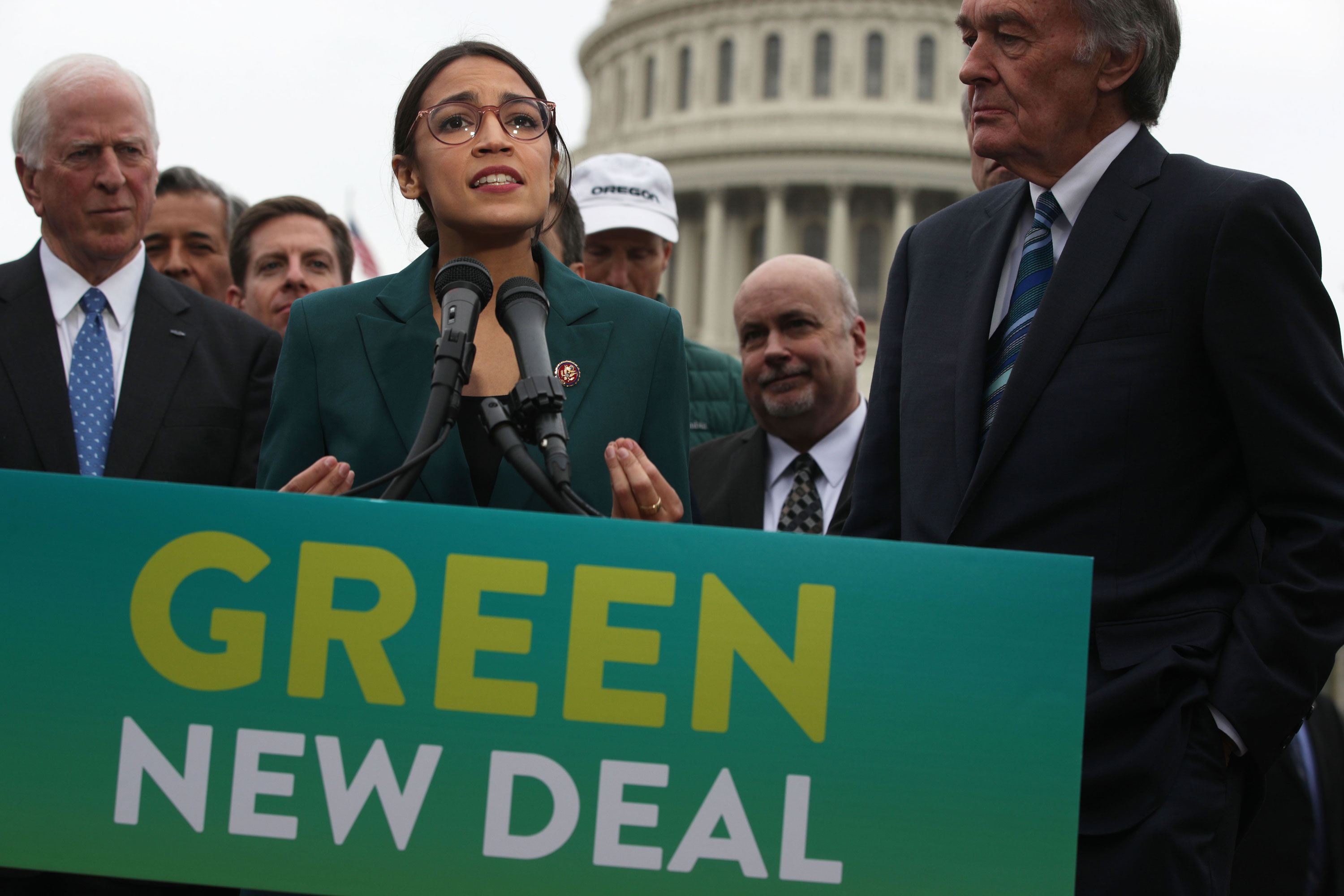The Green New Deal has been released. Here are four key tech takeaways

The promise of a “Green New Deal” has electrified US politics, but it has largely remained a loose set of goals rather than a defined list of policies: until now.
On Thursday morning, US Representative Alexandria Ocasio-Cortez of New York and Senator Ed Markey of Massachusetts, both Democrats, put forth a framework that finally elucidates at least some of the environmental package’s more concrete proposals.
Much of it was expected. It spells out the authors’ ambitions to slash greenhouse-gas emissions from agriculture, construction, energy, and transportation. It also mandates modernizing the grid and fortifying cities against climate disasters.
What’s more interesting is that the new framework finally provides new details on the mix of technologies that could be employed to accomplish these goals, addressing a hot-button issue that energy and environmental groups have already been vigorously debating (see “Let’s keep the Green New Deal grounded in science”).
Here are four key takeaways.
#1: Clean, not renewable
For some, the concern had been that the proposal would limit energy generation to renewable sources alone, mainly wind and solar, as hundreds of environmental groups had advocated.
Instead, the package adopts a relatively technology-agnostic approach to how we clean up the power sector, stating that the nation must meet “100 percent of the power demand in the United States through clean, renewable, and zero-emission energy sources.”
That seems to allow for the use of carbon-free sources like nuclear power and fossil-fuel plants with carbon-capture systems. Most energy researchers argue that such steady carbon-free sources will make it faster, easier, and less expensive to overhaul the energy system. That’s because wind and solar generation fluctuates wildly, which requires expensive forms of energy storage or transmission, in the absence of other consistent sources.
#2: No new nukes?
That said, at least one of the authors obviously wants to rapidly eliminate nuclear power and fossil-fuels plants.
An early version of an accompanying FAQ, released this morning from Ocasio-Cortez’s office, stated that the plan wouldn’t include any new nuclear plants, adding: “It’s unclear if we will be able to decommission every nuclear plant within 10 years, but the plan is to transition off of nuclear and fossil fuels as soon as possible.”
The nuclear language didn’t appear in a later draft, though. (Update: Still later, the FAQ disappeared from the site.)
“Although a fact sheet from one of the resolution’s sponsors has created confusion, the text of the actual resolution makes it abundantly clear—we must embrace every zero-carbon resource available to eliminate climate pollution and dramatically increase our investment in clean energy innovation,” said Josh Freed, senior vice president at Third Way, a clean-energy think tank, in a statement.
#3: “Natural” carbon removal
Both the UN’s climate panel and the US National Academies have concluded that we’ll need to remove massive amounts of carbon dioxide from the atmosphere in order to prevent dangerous levels of warming.
So another area of concern before the proposal was published was whether or not it would embrace methods of removing carbon dioxide directly from the air—and if so, in what form.
The released framework does specify that the law would allow or require “removing greenhouse gases from the atmosphere and reducing pollution,” but it gives clear priority to “proven low-tech solutions that increase soil carbon storage, such a preservation and afforestation.”
These kinds of approaches—planting trees and improved soil management— probably won’t be enough, according to the US National Academies report. That’s because they would place competing demands on agricultural lands needed to feed the world. That report called for significant federal funding for research and development in other approaches, like direct air capture machines that can suck carbon dioxide out of the sky. No mention of them appeared in the Green New Deal proposal.
#4: Possibly impossible
All told, the proposal betrays a clear preference for natural solutions and renewable power, with perhaps a grudging acceptance that other technologies may be required.
The broader question, of course, is how much this proposal will matter. It certainly won’t become law in anything like this form under the current Congress and president.
And whether it’s economically feasible to overhaul nearly the entire energy sector in a decade is highly questionable. Energy researcher Christopher Clack, chief executive of Vibrant Energy, found it would cost around $27 trillion "to build, operate and retire" all the necessary plants by 2030, he said on Twitter. That would run approximately $2.7 trillion a year.
Even if Democrats do retake the Senate and White House in 2020, the Green New Deal may still be doomed to fail. In addition to cleaning up the energy system, the proposal guarantees all Americans good-paying jobs, high-quality health care, clean water, and affordable food. Such a wide-ranging bill may not stand much of a chance whoever is in charge.
But some hope the sheer ambition of the Green New Deal becomes a rallying point in US politics that inspires legislators, activists, and voters, widening the window of what’s politically possible.
(This story was updated with revised cost estimates.)
Deep Dive
Climate change and energy
The problem with plug-in hybrids? Their drivers.
Plug-in hybrids are often sold as a transition to EVs, but new data from Europe shows we’re still underestimating the emissions they produce.
Harvard has halted its long-planned atmospheric geoengineering experiment
The decision follows years of controversy and the departure of one of the program’s key researchers.
Why hydrogen is losing the race to power cleaner cars
Batteries are dominating zero-emissions vehicles, and the fuel has better uses elsewhere.
Decarbonizing production of energy is a quick win
Clean technologies, including carbon management platforms, enable the global energy industry to play a crucial role in the transition to net zero.
Stay connected
Get the latest updates from
MIT Technology Review
Discover special offers, top stories, upcoming events, and more.